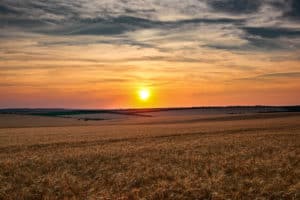My 24-year-old daughter, Molly, is a reporter/editor on the headline desk at Bloomberg News in New York. Through her employer, she has begun a retirement plan that is a diversified mix of stock indexes, bonds and the like. A real-estate IRA was not available to her.
This got me thinking about retirement options for Generation Y, individuals born roughly between the late 1970s and the late 1990s, Also known as Millennials, the oldest are now about 30.
Farmland and timberland have proven to be more profitable and less volatile long-term investments since 1960 than big caps, mid caps and small caps. (Bottle caps, however, may be another story.) So why, I thought, isn’t there a land-investment, retirement fund of this type that caters to Generation Y?
There is advantage in investing in both types of land at once. Agriculture provides annual cash flow, which would cover expenses, disbursements and, to some extent, purchases. A mix of Deep South farms that make sales during the winter with northern and western farms would provide cash income more or less regularly throughout the year. I would put my farm eggs into many baskets, not just one.
Small timberland tracts typically produce timber income in lump sums every 20 or 30 years for hardwoods; southern pine has a shorter rotation; and Pacific Northwest plantings have a longer rotation. Large timberland tracts can be managed for annual timber-sale revenue, but farm income would allow the Gen-Y Fund to store timber on the stump when it makes financial sense to do so.
Sales of both timber and land can be timed to jump on upward-trending prices.
My inclination would be for the fund to keep the most productive properties as revenue cores. The marginal lands around the cores could be sold as needed.
I would consider doing a little speculative value-investing, such as buying cheap environmentally abused land — like reclaimed mountain-top-removal surface coal mines — that might host a solar or wind-energy facility. I would also look for marginal farmland and timberland that better management could upgrade over time. I might also be interested in springs and reservoir sites, land that will become more valuable if the climate warms, land that does not require irrigation and land that can be adapted to higher agricultural and timber uses.
I don’t have any firm notions about how the fund should be set up.
A portfolio with many land parcels of different types and income characteristics would provide liquidity to the fund. The degree to which those earnings/gains and liquidity would translate into dividends and withdrawal capability is one of many issues to be determined.
Another set-up issue would be how client ownership should be structured. Could it take the form of a share in a fund or a REIT? Could something like a group real-estate IRA be established? Could it be a pension plan? Each option would likely have different tax consequences. The goal, I suppose, would be to combine client choice and flexibility, long-term appreciation and tax friendliness.
And, of course, the Gen-Y Fund should make money for those who set it up and manage it. I offer myself as head of acquisitions.
It would make sense to impose a minimum investment term, say no withdrawals for at least 15 or 20 years unless an emergency occurs. But dividends or distributions might be made annually, which clients could choose to reinvest.
Everything I’ve read suggests that the amount of investment fees is the critical variable in determining whether an investor makes money in a stock fund. Perhaps some graduated-fee arrangement could be established that offered lower fees to clients who left their money alone for say, at least 25 years, and higher fees to clients who wanted withdrawals sooner. Fees would have to be higher than a Vanguard index fund because of the required management. Maybe a land fund’s fees would be comparable to those charged for managing a pension fund.
While Gen-Yers are smart about technology, my guess is that they have also become smart about the volatility and risks of investing in both the stock market and technology. A Gen-Y Land Fund would be a retro-investment to the degree that it would be buying real assets that produce cash as both earnings and long-term gain.
The Fund could also offer its investors use of the properties. Take that Vanguard!
I’m serious about this.
This content may not be used or reproduced in any manner whatsoever, in part or in whole, without written permission of LANDTHINK. Use of this content without permission is a violation of federal copyright law. The articles, posts, comments, opinions and information provided by LANDTHINK are for informational and research purposes only and DOES NOT substitute or coincide with the advice of an attorney, accountant, real estate broker or any other licensed real estate professional. LANDTHINK strongly advises visitors and readers to seek their own professional guidance and advice related to buying, investing in or selling real estate.










We did this. Our market timing was bad. Super Idea. Email me and I will tell you all about it! Tim
Tim,
I would like to know how you did this as well. It sounds like a good idea. As a financial adviser I would like to know how one could set this up not just for 401K’s or pension plans but for the average investor.
I was just talking with a broker I deal with in Birmingham, Alabama and he does not deal with land in an IRA, but he gave me the phone number of someone that does. It is 205-985-0680. I do not have a name for anyone at that number. Michael Harrow.
Go to http://www.trustetc.com and read about investing retirement money in land. I have been doing the very sameforthe last 10 years
There are a couple of companies around that will set up a self-directed IRA for a very small fee. The owner then makes buying decisions. We are structuring some of these now and it’s a great way to divesify a portfolio. As usual, some caveats …particularly personal use rules and running afoul of the SEC. Great idea for 401K conversions, but expect delays. Fund managers don’t like handing over accounts.
I am familiar with the process in helping clients set up IRA’s to purchase land. But its like was mentioned earlier. The client can’t use the land. Thats a turn off to some investors who would like to use their IRA money to purchase an investment property but would also like to hunt or garden on that property until they are ready to sell it. Thats why I like the idea of a fund where the clients could have use of the property. Any idea’s on how one could set that up? My thoughts are that it may end up like more of a partnership or TIC than a fund. What do the experts say?
Mr. Morris is right about the owner of a real-estate IRA being prohibited from using the land in that account.
I don’t think, however, that an owner of one real-estate IRA would be prohibited from using the land in another real-estate IRA managed by the same outfit.
But I think some other structure probably lends itself to a retirement fund better than a collection of real-estate IRAs.
I have set up parcels of land in Ohio for investing groups where they purchase said properties. After a 3 yr period we divide said lands and offer owner financing at 12% interest.
Get that interest rate from a mutual fund.
Sell out generally in 3-5 year term and do it again.
Bill Gates just bought over 4,000 acres in Ohio.. wonder what he was thinking…??